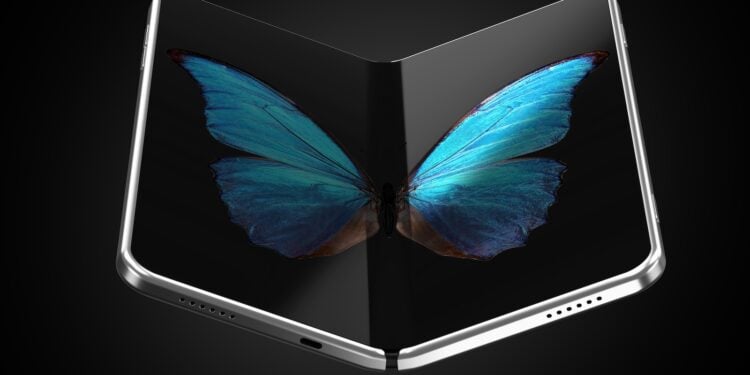The iPhone Fold remains one of Apple's most exciting, yet mysterious, projects. Speculation about a foldable iPhone has been rife for years, but concrete details are scarce. Now, there's new evidence that Apple has apparently found a way to reduce costs in the development of the hinge—the central component of the foldable design. Renowned analyst Ming-Chi Kuo estimates that the hinge's production could be significantly cheaper than previously thought.
The hinge is the heart of every foldable smartphone. It determines whether the device is stable, durable, and suitable for everyday use. At the same time, it is considered one of the most expensive and technically demanding components in the entire assembly. Apple is expected to develop a mechanism for the iPhone Fold that is both precise and robust, while also meeting the company's high design and quality standards. Despite these stringent requirements, Kuo says production costs could be significantly lower than expected—a key factor in the potential market success of the iPhone Fold.
The hinge as a core component
The key feature of the iPhone Fold is its foldability, which is based on a sophisticated hinge mechanism. This component ensures that the screen bends evenly between open and closed positions without sustaining damage. For Apple, this mechanism is crucial to maintaining the balance between functionality, durability, and its signature minimalist design.
Developing such a hinge is complex and costly. It must be strong enough to withstand thousands of folds, but at the same time, it must not take up too much space or add unnecessary weight to the device. This is precisely where Apple appears to have made progress, which could have a direct impact on production costs.
Significantly lower production costs
According to new estimates by Apple analyst Ming-Chi Kuo, the production costs for the iPhone Fold hinge are expected to be around $70 to $80 per unit. This would be about $20 to $40 lower than the previously estimated $100 to $120. This reduction is strategically important for Apple, as it could lower the overall cost per device and thus create flexibility for pricing and profit margins.
The fact that a component so critical to the device's functionality can be manufactured more cheaply than the market expects speaks volumes about advances in manufacturing and design. Apple is likely to benefit from its close collaboration with experienced suppliers.
Collaboration with Foxconn and Shin Zu Shing
Production of the hinge will be handled by two companies: Foxconn, a long-time Apple partner, and Shin Zu Shing. The two companies are working together in a joint venture that has secured approximately 65 percent of the total hinge orders. Amphenol will handle the remaining share.
According to Kuo, a third manufacturer could be added in the long term. Luxshare, another well-known Apple supplier, is considered a possible new entrant, but not until after 2027. The increasing interest from additional manufacturers is seen as a good sign for Apple. Increased competition within the supply chain could further reduce production costs in the long term, thus increasing profit margins.
Materials and construction
Previous rumors suggest that the iPhone Fold could look like two iPhone Air models joined together. The frame is said to be made of titanium and aluminum—materials that are both lightweight and very strong. This combination would allow the device to be thin and robust without compromising on feel.
In earlier assessments, Ming-Chi Kuo also suggested a stainless steel frame or a liquid metal hinge. While these materials would be particularly durable, they would also result in significantly higher weight. Therefore, it seems more likely that Apple will opt for lightweight metals to make the device suitable for everyday use and comfortable to hold.
Possible market launch
Everything indicates that Apple will officially unveil the iPhone Fold in September 2026. This would mark the company's first fully foldable iPhone, roughly seven years after rumors first surfaced about such a model.
Since 2019, the foldable iPhone has repeatedly been considered "close to release," without any concrete information. Now that seems to be changing. Evidence from the supply chain and assessments by analyst Ming-Chi Kuo suggest that Apple has advanced development to the point where market readiness is within reach.
Manufacturing capacity for the hinges has already been planned, and partner companies Foxconn, Shin Zu Shing, and Amphenol are also expected to prepare for a production phase in 2026. A cheaper hinge could play a key role in this, as it would reduce manufacturing costs and make the launch of the iPhone Fold more economically attractive.
- Foldable iPhone 2026: No fold – Apple's biggest breakthrough?
- iPhone Fold: Why Apple's foldable phone is ahead of the competition
- The iPhone Fold is said to offer two key advantages
- iPhone Fold: How Apple wants to overtake the competition
- iPhone Fold: Titanium meets aluminum in a new design
The iPhone Fold is within reach
The iPhone Fold is evolving from a years-long rumor into a tangible product. The latest information on the reduced production costs of the hinge shows that Apple is making clear progress in development and getting manufacturing costs under control.
The combination of technical precision, lightweight construction, and a robust folding mechanism is likely to form the core of the upcoming device. With its planned launch in September 2026, the iPhone Fold is moving within a realistic timeframe for a market launch for the first time.
If Ming-Chi Kuo's estimates prove correct, Apple is on the verge of a decisive step: a foldable iPhone that is not only technically sophisticated but also economically viable to produce. The iPhone Fold could thus mark the entry into a new generation of devices – and give Apple a head start in a market previously dominated by competitors. (Image: Shutterstock / Wit Olszewski)
- Apple develops AR glasses with two modes and visionOS system
- Apple develops H3 chip and prepares new AirPods models
- Three new Apple products could be released this week
- iOS 26.0.2 coming soon – Apple prepares another update
- Apple is working on glasses – AR experience comes with successor model
- When will the M5 MacBook Pro be released? Current information at a glance
- Apple could unveil several new products next week
- Apple Health+: New subscription service could launch in 2026
- iPhone Fold: Titanium meets aluminum in a new design
- Apple is close to an agreement with Formula 1
- iPad Pro & MacBook Pro: Supply bottlenecks point to update
- Jony Ive and OpenAI: Three problems slow down AI hardware
- iPad mini 8: Rumors, technical features & release date
- iPad Pro Upgrade: Faster, more powerful – but without a second camera
- Apple is working on glasses – AR experience comes with successor model
- Apple launches reorganization: New head of AI sought
- Apple Vision Pro: New Dual Knit Band for more comfort?
- Apple pursues rare strategy in launching smart glasses
- Apple plans AI smart glasses and stops Vision Air development
- iPhone Fold 2026: Apple's first foldable smartphone in detail
- Apple M5 chip leak reveals powerful GPU performance in the iPad Pro
- New Siri features could become reality with iOS 26.1
- Apple accelerates production of M5 Macs and displays
- Apple is testing LLM Siri internally with a ChatGPT-like app





